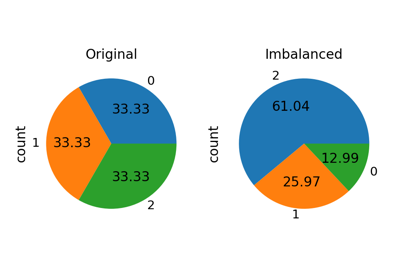make_imbalance#
- imblearn.datasets.make_imbalance(X, y, *, sampling_strategy=None, random_state=None, verbose=False, **kwargs)[source]#
Turn a dataset into an imbalanced dataset with a specific sampling strategy.
A simple toy dataset to visualize clustering and classification algorithms.
Read more in the User Guide.
- Parameters:
- X{array-like, dataframe} of shape (n_samples, n_features)
Matrix containing the data to be imbalanced.
- yarray-like of shape (n_samples,)
Corresponding label for each sample in X.
- sampling_strategydict or callable,
Ratio to use for resampling the data set.
When
dict, the keys correspond to the targeted classes. The values correspond to the desired number of samples for each targeted class.When callable, function taking
yand returns adict. The keys correspond to the targeted classes. The values correspond to the desired number of samples for each class.
- random_stateint, RandomState instance or None, default=None
If int, random_state is the seed used by the random number generator; If RandomState instance, random_state is the random number generator; If None, the random number generator is the RandomState instance used by np.random.
- verbosebool, default=False
Show information regarding the sampling.
- **kwargsdict
Dictionary of additional keyword arguments to pass to
sampling_strategy.
- Returns:
- X_resampled{ndarray, dataframe} of shape (n_samples_new, n_features)
The array containing the imbalanced data.
- y_resampledndarray of shape (n_samples_new)
The corresponding label of
X_resampled.
Notes
See Multiclass classification with under-sampling, Create an imbalanced dataset, and How to use sampling_strategy in imbalanced-learn.
Examples
>>> from collections import Counter >>> from sklearn.datasets import load_iris >>> from imblearn.datasets import make_imbalance
>>> data = load_iris() >>> X, y = data.data, data.target >>> print(f'Distribution before imbalancing: {Counter(y)}') Distribution before imbalancing: Counter({0: 50, 1: 50, 2: 50}) >>> X_res, y_res = make_imbalance(X, y, ... sampling_strategy={0: 10, 1: 20, 2: 30}, ... random_state=42) >>> print(f'Distribution after imbalancing: {Counter(y_res)}') Distribution after imbalancing: Counter({2: 30, 1: 20, 0: 10})
Examples using imblearn.datasets.make_imbalance#

Fitting model on imbalanced datasets and how to fight bias




